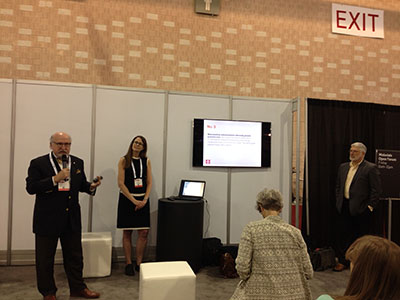By Mary Ann Lazarus, FAIA, LEED AP BD+C / COTE 2016 May Newsletter

Friday May 20, 2016 7 AM AIA Convention, Philadelphia, PA –
A robust crowd gathered in the Philadelphia Convention Center to hear about the new AIA Whitepaper on Materials Transparency and Risk for Architects which was just issued in April 2016. The Whitepaper tells architects what they can do to promote materials transparency in their projects while managing risk. The panelists included three experts who participated in the development of the Whitepaper: Brodie Stephens, General Counsel at Perkins + Will; Frank Musica, Senior Risk Management Attorney at Victor O. Schinnerer & Co., Inc. and Mike Davis, FAIA, President of Bergmeyer.
These three were among the 20 plus architects, lawyers, insurance industry leaders, and AIA staff who gathered in 2015 to address the key questions that architectural firms who are pushing materials transparency in their projects are asking. Questions such as:
- If I knowingly specify a building material that contains toxic substances, isn’t that a negligent action? Does that action make me liable for potential health impacts?
- Architects are not trained in toxicology or human health. What can design professionals do with information about toxic substances in building products?
- Will our professional liability insurers cover us for potential negligence claims related to materials transparency?
- What should we tell our clients that we can or will do with knowledge
- ·of the content of building materials?
These questions directly relate to the AIA Board’s Materials Transparency position statement that encourages architects to promote transparency in materials’ contents and their environmental and human health impacts.”

This topic is very timely given the increasing mainstream media attention on the health and environmental impacts of materials. “The train has left the station on the need for transparency”, says Brodie Stephens. Big Box product providers like Walmart and Target are creating health and environmental criteria for all products on their shelves. Leading clients like Google and Kaiser Permanente are establishing their own environmental and health standards for construction and furniture products. Architects are in a great position to lead on this issue and take advantage of the great opportunities if they understand and manage their liability limitations.
The Whitepaper gives the answers on how to address risk while promoting transparency, looking at three different firm scenarios – architect driven, client driven, and certification system driven (e.g. LEED or Living Building). Mike Davis, who led the AIA’s Materials Risk Task Group, says it clearly: “We think these best practice recommendations create a “safe space” for architects to promote transparency in their practices without incurring uninsurable risk.”
The Whitepaper identifies a few key actions that firms should take:
- Be clear about your intent with your client: explain why you’re promoting materials transparency
- Make reference to unambiguous goals such as meets LEED criteria
- Use recognized third party compliance documents such as Health Product Declarations (HPDs) or Environmental Product Declarations (EPDs)
- Do NOT claim expertise you do not have – Architects are not industrial hygienists and cannot evaluate the potential of a health impact
- Do NOT make guarantees or warrantees about the actual absence or presence of substances in the built environment
- Be sure your clients understand that material content is one of many selection criteria that must be weighed.

The following are testimonials that show how the overall message hit home with attendees.
Leonard Kady, AIA of Leonard Kady Architecture + Design states: “I believe that the simple act of being aware and learning basic properties of materials in the context of their environmental impact can be transformative. Ultimately independent testing and reporting is critical part of our ability to be able to discern what materials we accept and hold to be worthy of promoting.”
Rand Ekman, AIA, Chief Sustainability Officer at HKS saw the need for broad application of the recommendations: “This session clarified that project teams must address the relationship of human health and materials with our clients from contract negotiation to project delivery. In addition to being the right thing to do, this is crucial to managing a firm’s risk.”
You can review the full Materials Transparency Whitepaper and the related AIA Contract Documents helpful B503 supplementary language here.
________________________________
Return to the 2016 COTE May Newsletter cover.